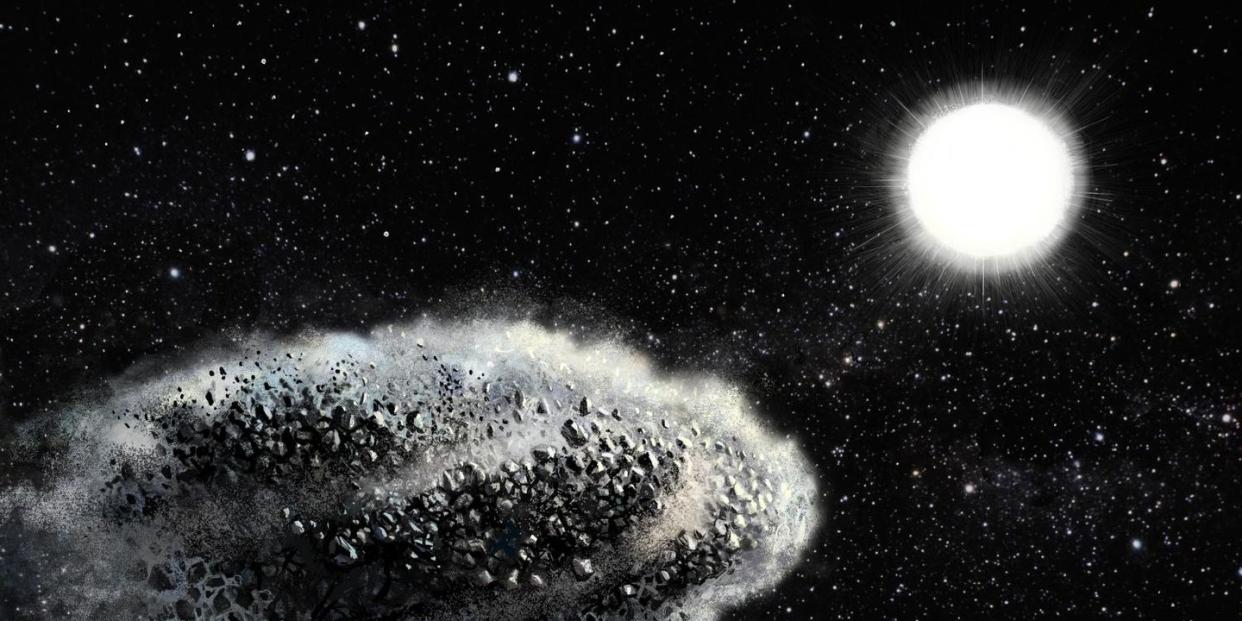Our Swollen Sun Will Someday Shatter Everything in the Asteroid Belt

When the sun enters its red giant stage in about six billion years, scientists say it will cause a chain reaction of exploding asteroids in the asteroid belt.
These small rocky bodies will explode thanks to the YORP effect, a phenomenon in which the sun's radiation causes rapid changes to the rotation of asteroids.
After the sun expands into its red giant stage, it will shrink into a white dwarf.
Between five and six billion years from now, astronomers say the sun will expand into an even bigger fireball, swallowing almost half the solar system. This rapid expansion into its red giant stage is likely to send asteroids in the asteroid belt between Mars and Jupiter tumbling.
You can thank the YORP effect. Stars emit infrared radiation into space, which carries momentum in addition to heat and can change the orbit—a phenomenon called the Yarkovsky effect—as well as the rotation and orientation of nearby small bodies such as asteroids. The YORP effect, named for the four scientists who contributed to its discovery—Yarkovsky, O’Keefe, Radzievskii, and Paddack—was directly observed in 2007, when scientists noticed the asteroid 54509’s YORP rotation changed.
Asteroids that absorb this momentum-packed sunlight eventually re-radiate it back out into space as heat, which creates small amounts of thrust, thus inching the rocky bodies from their original path or causing them to spin faster and faster. Because most asteroids are "rubble piles"—loosely packed blobs of dust, rock and ice—many won't be able to withstand the forces of this increased rotation and will shatter, flinging rocky debris far out into the solar system.
Stars undergo several important stages before they eventually die. Our sun, a yellow dwarf, is currently in the main sequence stage of its life. Right now, the heat the sun radiates doesn’t have much of an influence on the rocky bodies in the asteroid. But that could change when our sun begins to expand out into the solar system.
“When a typical star reaches the giant branch stage, its luminosity reaches a maximum of between 1,000 and 10,000 times the luminosity of our sun.” astrophysicist Dimitri Veras, of the University of Warwick in England, said in a statement. “The YORP effect in these systems is very violent and acts quickly, on the order of a million years.” Veras leads a team of researchers who published this research last year in the Monthly Notices of the Royal Astronomical Society.
After the branch stage, our shiny neighbor will eventually shrink back down into a super-hot, super-dense, Earth-sized white dwarf. The rocky debris created in this violent event will begin to form a disc around the star, and then eventually get sucked in.
By then, the damage will have already been done. “Not only will our own asteroid belt be destroyed,” Veras said, “but it will be done quickly and violently. And due solely to the light from our sun.”
You Might Also Like

 Yahoo News
Yahoo News 
